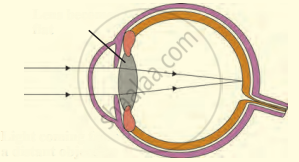Advertisements
Advertisements
Question
The descriptions of five kinds of images are given below:
(a) diminished and virtual
(b) enlarged and real
(c) enlarged and erect
(d) real and inverted
(e) virtual and the same size
Which one of these describes the image formed:
(i) on the retina of the eye?
(ii) by a magnifying glass?
(iii) by a convex driving mirror on a car?
(iv) by a plane mirror?
(v) on the screen of a slide projector?
Solution
| Sl. no. | Image formed | Kind of image |
| 1 | On the retina of the eye | Real and inverted |
| 2 | By a magnifying glass | Enlarged and erect |
| 3 | By a convex driving mirror on a car | Diminished and virtual |
| 4 | By a plane mirror | Virtual and same sized |
| 5 | On the screen of a slide projector | Enlarged and real |
APPEARS IN
RELATED QUESTIONS
After testing the eyes of a child, the optician has prescribed the following lenses for his spectacles:
Left eye : + 2.00 D
Right eye : + 2.25 D
The child is suffering from the defect of vision called:
(a) short-sightedness
(b) long-sightedness
(c) cataract
(d) presbyopia
What is a lacrimal gland?
Sometimes you remember a vivid picture of a dream you saw. What is the role of your eyes in this experience?
With reference to the functioning of the eye, answer the question that follow:
Name the cells of the retina and its respective pigments which get activated in the dark.
Name the following:
The innermost layer of the eye
The following figure show the change in the shape of the lens while seeing distant and nearby objects. Complete the figures by correctly labelling the diagram.

Explain the structure and functioning of Human eye. How are we able to see nearby as well as distant objects?
Match the following:
| Column - I | Column - II |
| 1. Retina | a. Path way of light |
| 2. Pupil | b. Far point comes closer |
| 3. Ciliary muscles | c. near point moves away |
| 4. Myopia | d. Screen of the eye |
| 5. Hypermetropia | e. Power of accommodation |
Name the following:
Three layers of the eye ball.
